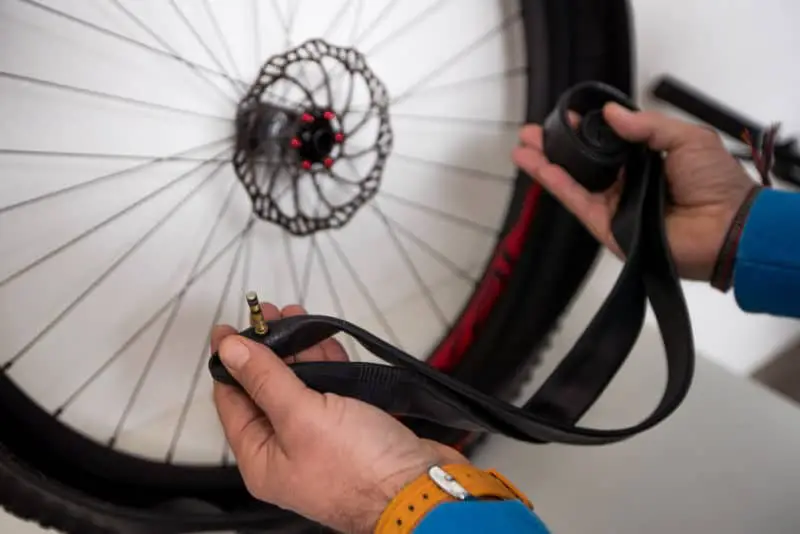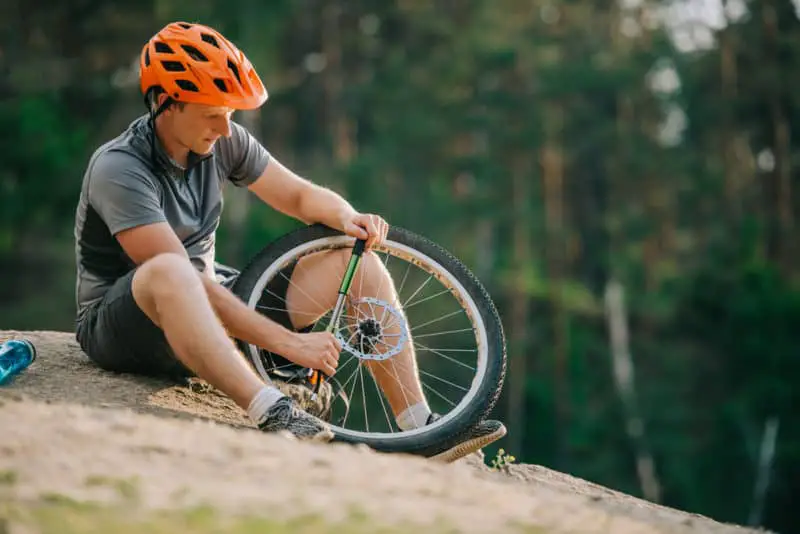Ask any experienced mountain biker the best way to instantly improve the way your bike handles, and most of them will tell you to get rid of those inner tubes you’re running in your tires.
Tubeless tire technology has been around in the mountain biking world for quite a while now, and for good reason. Riding tubeless will improve your bike’s grip, traction and cornering ability, making you feel more confident on challenging terrain.
So if tubeless tires are the way to go, will your mountain bike tires be tubeless right off the shop floor? Or will you have to remove the tubes yourself?
Most decent mountain bikes will come stock with tubeless tires. As tubeless tires are better in almost every way, bike companies want to save you the hassle of removing the tubes yourself. Some bikes may ship with tubes installed to protect the tire during transportation, but this will be easy to determine.
Though most bike brands spec high quality tubeless tires with their builds, not all aftermarket tires can be run tubeless. How do you know whether your tire can be run tubeless or not? And why should you carry a spare tube on your rides even if you have tubeless tires? If you’re ready to learn everything you ever wanted to know about mountain bike tubes, keep reading!
Which Mountain Bike Tires Need Tubes

If you buy a mountain bike from a major name-brand, you can be fairly certain your tires can be run tubeless. However, if you choose a budget bike or buy cheap aftermarket tires, you might be stuck running tubes.
Cheap tires are not constructed durably enough to be used without a tube. They will have thin sidewalls, which don’t provide much puncture protection. They will also have a rounded bead: the inside edge of the tire which pushes against the inside of the rim. This bead shape doesn’t provide enough contact with the rim to keep the tire on when inflated without a tube inside.
I highly recommend avoiding cheap tires for many reasons: they will provide less traction, grip and cornering stability, will puncture more easily, and will generally wear out much sooner than a high quality tire. The tire is the only part of the bike in contact with the ground. If you don’t have grip, you’re compromising your own safety when riding.
Good tires aren’t cheap (they usually cost $70 or more), but they’re absolutely worth it!
However, even the best tires can’t be run tubeless if you don’t have tubeless compatible rims. A tubeless compatible rim will feature an inner sidewall with a hooked shape at the top. This is meant to catch and hold onto the tire, keeping it in place when inflated. A hookless rim will not be able to hold a tubeless tire, and must be run with an inner tube.
Visually inspect your rims before attempting to convert your tires to tubeless to make sure they’re compatible. Otherwise, you’ll need to buy new rims…and if you thought good tires were expensive, just wait until you see how much rims cost!
Which Mountain Bike Tires Do Not Need Tubes

Tires from major brands such as Maxxis, Continental, Michelin, Schwalbe and others are designed to be run tubeless. How do you know? They will say “Tubeless Ready” (or something to that effect) right on the tire casing.
A tubeless tire has a square bead to provide more contact with the hook design on the inside of a tubeless compatible rim, and a thicker sidewall to aid in puncture protection.
Most brands offer tubeless tires in casings of varying strengths (such as the EXO, EXO+, Double Down, and Downhill casings available from Maxxis, listed from lightest to most robust), allowing you to choose the best casing for you based on your weight and riding style.
Some bikes (from direct-to-consumer brands or used bikes shipped from a company such as The Pro’s Closet) may ship with tubes installed to protect the tire from damage during transportation.
To check whether this is the case, remove your wheel, deflate the tire, and pull the sidewall in toward the center of the rim. This takes quite a bit of force with a tubeless tire seated on a hooked rim, but once you do so, you’ll be able to see whether a tube is present or not.
Be sure to do this from the top of the tire with it standing upright: if the tire is tubeless, it will contain sealant, which you don’t want to spill everywhere!
Can You Use an Inner Tube in a Tubeless Tire?
Even a tubeless tire can run an inner tube, and there may be a couple situations in which you would want (or need) to do so.
First, an inner tube can be used during an emergency repair when your tire has sustained a puncture too large for a tire plug or the sealant inside to fix properly. In this case, installing a tube will allow you to continue your ride until you can make a more permanent repair. It may just prevent you from needing to walk your bike all the way back to the car!
Even if you run tubeless tires, you should carry a spare inner tube in your riding gear as part of your emergency repair kit at all times.
Second, a tube can be useful if you plan on riding in very rocky terrain. Trails with lots of sharp rocks can easily puncture your tires. Having a tube in place can prevent flats when the tire sustains small punctures. If you tend to get a lot of flats on a certain trail, it might be a good idea to put tubes in before you ride: better than needing to do it midway through your ride!
What Size Inner Tube Do You Need?
Wouldn’t it be terrible to need to use your emergency inner tube for a trailside repair, only to discover it’s the wrong size for your tire?
Just like tires, not all tubes are the same size. And while it may seem obvious that you need to get a tube that matches your tire’s diameter (27.5 or 29), you also need one that’s compatible with your tire’s width.
If your tube is narrower than the tire, it won’t provide enough support and stability when fully inflated, causing your tire to feel squishy and uneven. If it’s wider, you won’t be able to inflate it to the correct pressure without the tire potentially being forced off the rim.
Tubes have a range of acceptable tire widths they’ll work within. This is really convenient, because many bikes come with front and rear tires of differing widths. A wider front tire will improve grip and braking traction, while a narrower rear tire will decrease rolling resistance. Find a tube that works with both widths, and you only need to carry one spare in your pack.
Are Tubeless Tires Better?
If you’ve been on more than a few rides and still have tubes in your mountain bike tires, you’re definitely among the minority! Tubeless tires have many significant advantages over tubes.
First, tubeless tires provide better grip in all situations, especially while riding steep, off-camber terrain or trails with lots of rocks and roots. They also improve traction while accelerating, braking and cornering.
How do they do this? By allowing for the use of lower air pressure compared to tires with tubes. Tubeless tires can be run much softer, which enables them to better conform to the trail and all of its obstacles. Whereas a firmer tube tire may bounce over a root at high speed, a tubeless tire can absorb the root, like water taking the shape of whatever vessel it fills.
The more contact a tire has with the ground, the more traction and grip it can provide. A tire bouncing over everything in its path just can’t compete. Tubeless tires can typically be run 5-8psi lower than their tube counterparts, which may not sound like much, but it will make a huge difference in how the tire feels!
For more on how tubeless tires feel compared to tires with tubes, check out one of my previous articles: Do Tubeless Bike Tires Feel Different? (Are They More Comfortable?)
Second, tubeless tires remove the risk of pinch flats. A pinch flat can occur when you impact a hard or sharp trail obstacle (like a rock) and your tube gets pinched between the tire and the rim, causing it to rupture. No tubes, no pinch flats! Tubeless tires are at less risk of getting a flat anyways, since they have thicker sidewalls to protect against this problem.
Third, and as minor as it may be, tubeless tires are lighter than tires set up with tubes. Tubes don’t weigh much (maybe 100-200g depending on diameter and width), but they do weigh something. And they add weight to the worst possible place you can add weight: the wheels.
The more rotating mass you add to your bike, the slower it will accelerate, decelerate, and change direction in general. While some of the weight savings by switching to tubeless will be offset by the addition of liquid tire sealant, it will still have some effect. The larger your wheels (29er vs. 27.5) the more you will notice the weight difference.
The many benefits, combined with the relative ease of making the conversion, means there really isn’t any reason not to go tubeless if you’re still running tubes!
Going Tubeless: An Easy Choice!
There are a lot of hotly debated topics in mountain biking: are 29ers or 27.5 wheels better? Should you buy one bike that does everything pretty well or multiple bikes that each specialize in something? Is electronic shifting a fad or the future?
But one thing that everyone seems to agree on is that tubeless tires are the clear choice in all situations. If you’re still running tires with tubes, it’s time to reap the benefits of tubeless tires before you head out on your next ride. So keep those tubes where they belong: in your riding kit for emergency use only.
You’ll be amazed at how tubeless tires instantly improve how your bike feels and handles, and will wonder why you waited so long to make the switch!
